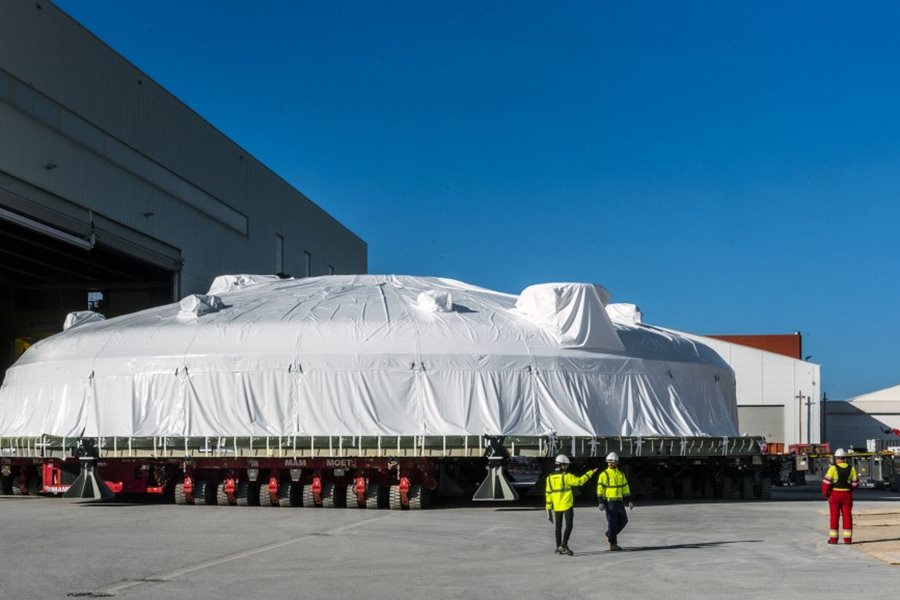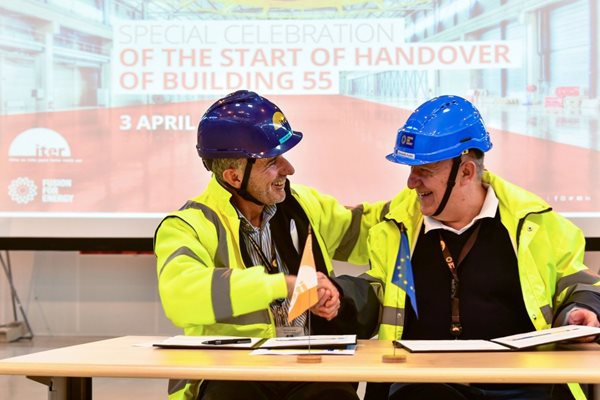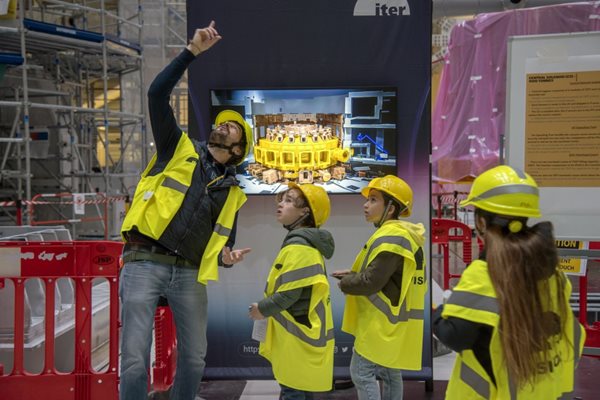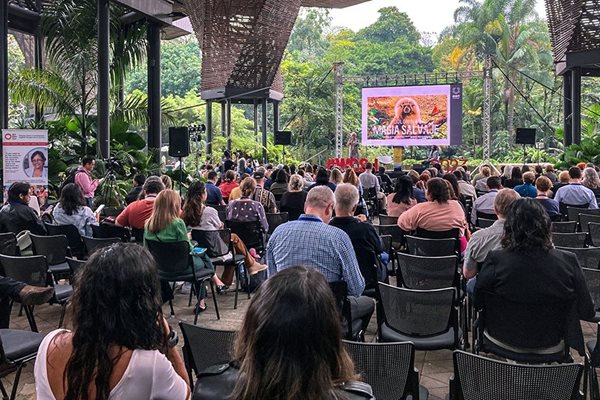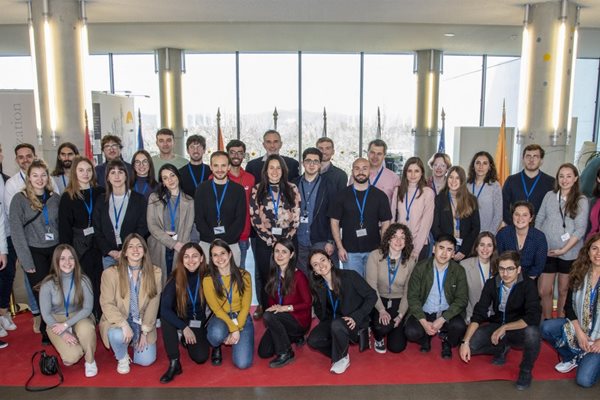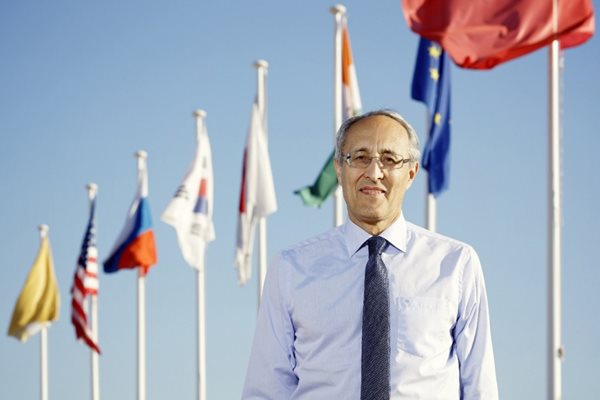
you're currently reading the news digest published from 01 Apr 2023 to 11 Apr 2023
featured5
of-interest2
press19
featured
Cryostat top lid | Big muscle for a huge load
It takes a lot of muscle to move a 900-tonne load. On Thursday 6 April, no less than six self-propelled modular transport platforms, each equipped with a 500 HP power pack, worked in unison to move the cryostat top lid and its massive support frame from the workshop where it was assembled and welded to an exterior storage area a few dozen metres away. At 665 tonnes, the cryostat top lid is the second-heaviest¹ component of the ITER machine. Its main elements, manufactured by ITER India contractor Larsen & Toubro Ltd, were delivered to ITER in the fall of 2020. The onsite assembly and welding of this fourth and last section of the 16,000-cubic-metre cryostat took a little more than one year. By February 2023, the top lid had been sealed away in tight wrapping and was ready to be placed in outdoor storage. The perception of size depends on the environment. Sitting at the far end of the Cryostat Workshop, the top lid certainly felt like a large component. But as it slowly came out of the building, amidst the roar of the power packs, it seemed to have dramatically grown in size. The 30-metre-in-diameter, 10-metre-tall load dwarfed everything around it. It will be some years before the top lid 'closes' the giant vacuum chamber that surrounds the ITER Tokamak at the end of core machine assembly. In the meantime, the flying-saucer-shaped component will sit securely on a bespoke heavy-duty slab protected from dust and moisture by leak-tight wrapping, its surface monitored by strategically positioned cameras. ¹ At 1,250 tonnes, the cryostat base, which was installed in the Tokamak assembly pit in May 2020, is the heaviest single machine component.
Coil winding facility | Toward new activities
In August 2010, close to 13 years ago, construction work began on a vast workshop for the manufacturing of ITER's largest ring-shaped coils. Designed and financed by Europe, the Poloidal Field Coils Winding Facility was the first building to rise on the ITER platform. Since, it has been host to one of ITER's most spectacular and challenging industrial ventures: the step-by-step fabrication, under the responsibility of procuring agency Fusion for Energy, of four poloidal field coils ranging from 17 to 24 metres in diameter and from 200 to (nearly) 400 tonnes in weight. As the last two coils enter late-stage production activities at the far end of the assembly line, the rest of the building has become available for other tasks. On Monday 3 April, Fusion for Energy handed over approximately one-fourth of the shop floor to the ITER Organization for assembly and installation activities. In the coming months, after a large door is created in the north wall facing the cryoplant, the ITER Organization will use the space previously occupied by the coil winding table and adjacent work station to proceed with thermal shield repairs. Later this year, in September, a second partial handover will extend the Organization's 'exclusive area' to about half of the facility's space. In this newly acquired territory, ITER will set up the port plug test facility, whose components will arrive from Russia. By mid-2024, after the final coils PF4 and PF3 have been delivered and all coil-related activity has ended, a final handover will give the ITER Organization complete ownership of the building. At the far end, where the concrete slab can withstand pressures on the order of 42 tonnes per square metre, ITER will conduct divertor cassette assembly operations and other heavy-duty activities. 'More than a formal handover, what we are celebrating today is the quality of the work which has been and continues to be done in this building,' said ITER Director-General Pietro Barabaschi before signing the official documents with his counterpart, Fusion for Energy Acting Director (interim) Jean-Marc Filhol. The Poloidal Field Coils Winding Facility was not merely an industrial building, it was a place where unique tools and processes were refined and optimized, and where knowledge and skills were acquired by dozens of different actors working in synergy to produce the largest superconducting coils ever designed.
Open Doors Day | Enthusiasm and dedication
The 18th edition of Open Doors Day took place on a sunny weekend in early April, to the satisfaction of approximately 700 visitors. A large team of volunteers facilitated the event, each one sharing his or her 'piece' of ITER. Open Door Days take place twice a year at ITER, barring events outside of our control, but they never get old. Each time, the enthusiasm of the public and the dedication of specialists from all corners of the project combine to make for a fulfilling day. Visitors leave with a better sense of ITER's scientific mission and the intricacies involved in building the world's largest magnetic confinement fusion device, while insiders have the pleasure of stepping back from their demanding day jobs to share their enthusiasm for ITER's overall mission. In addition to staff and contractors from the ITER Organization and the European Domestic Agency Fusion for Energy, who volunteered their time, many other people contributed to the smooth operation of the daylong event, including those who handled registration, security, and hospitality. Julie Marcillat, from the ITER Communication, orchestrated the event. See the gallery below for scenes from the latest Open Doors Day at ITER.
Science journalism | Meeting ITER in Medellín, Colombia
What a setting for a conference! A sprawling expanse of green, the large botanical garden of Colombia's second biggest city Medellín provided the venue for the 12th World Conference of Science Journalists. About four hundred journalists, media experts and communicators from all corners of the globe met in person in the 'city of eternal spring' to exchange experiences, share ideas and learn from one another. In a somewhat sobering contrast to the pleasant surroundings, the conference addressed a number of serious themes affecting public discourse across the world. As it was the first conference since the COVID pandemic, this subject was one of the hottest topics—in particular its impact on science journalism and the need to confront disinformation and misinformation. Journalists examined a range of other crucial issues, such as the role of public policy in science and technology, food security and food safety, and the practical and ethical implications of new biotechnologies. Focus sessions dealt with the essence of the journalistic trade—reporting on risk and uncertainty in science, the question of whether humour has its place in science journalism, or the use of new media technologies. Climate change was the underlying theme for many discussions. Here in particular, it was interesting to note the move toward solutions-oriented journalism, focusing on exploring answers to challenges rather than just dwelling on problems. The plenary on energy security—with ITER's participation—was a good example. Panellists discussed access to energy, with an emphasis on the development of energy solutions that are environmentally sustainable in a world that has to deal with the increasing effects of climate change. The presentation of the ITER Project—both at the conference's 'story corner' as well as in the plenary—raised the question of how developing countries will be able to benefit from fusion technology in the future. In anticipation of concrete political measures to enable the worldwide sharing of fusion technology, it was agreed that steps could and should be taken now to stimulate the development of fusion-related scientific and technological capacities through targeted investment in education and research in developing countries. The World Conference of Science Journalists provided yet another stage to show that fusion is a long-term solution for addressing the world's energy problems and helping to combat the effects of climate change. Many invitations were extended to conference participants, and the ITER Project hopes that science journalists from all over the world will visit for a first-hand experience!
Image of the week | European trainees get a taste of ITER
In order to grasp the reality of a project they will be working for from afar, 30 university graduates completing a 12-month traineeship at Fusion for Energy headquarters in Barcelona, Spain, recently spent two days at ITER. Organized by Fusion for Energy, the program included a visit of the ITER site, meetings with experts in different fields of competence, and a get together with ITER Organization counterparts. The visit was part of an ongoing effort to better integrate the personnel of the ITER Organization and Fusion for Energy and, as a number of trainees are likely to become staff, to create a pool of younger talent for the global ITER Project.
of-interest
The ITER Podcast: Episode 2, Season 2
Episode 2 of The ITER World, ITER's second podcast miniseries, is now available. "Visiting Planet ITER" takes the listener into the heart of ITER's assembly activities, where visitors from France, Thailand and the Netherlands are discovering the project and sharing their views about ITER's goals and nuclear fusion energy overall. Kirsten Haupt, from the ITER visits team, lifts the veil on the popular ITER visitor program that attracted approximately 20,000 people last year, and nearly 200,000 since it started in 2007. Listen to "Visiting Planet ITER" with host Kruti Mawani Fayot directly on the ITER website or through the following channels: Amazon Music, Apple Podcasts, Google Podcasts, PodBean, Spotify, Tune In and World Radio Paris. Visit the podcast page of the ITER website.
EUROfusion Bernard Bigot Researcher Grants
The European Consortium for the Development of Fusion Energy, EUROfusion, has launched a call for applications for the next round of EUROfusion Bernard Bigot Researcher Grants, which will fund up to ten outstanding early-career researchers for research projects starting in the first half of 2024. The grants will cover their salaries and part of the cost of their research activities and missions for up to two years. To be eligible, candidates must currently hold a PhD and have defended their doctoral thesis within the two years preceding the submission deadline. Interested candidates should jointly prepare their application with a EUROfusion consortium member, who will submit the application and offer to employ the candidate for the proposed duration of the project. Interested candidates can join the EUROfusion Training and Education Office's Q&A Information Session on Wednesday, 19 April 2023, at 14.00 CET. Further details on the overall procedure and the information session are provided on this website. The submission deadline is 28 April 2023. --The Researcher Grants are named after Dr Bernard Bigot, Director-General of the ITER Organization from 2015 to 2022.
